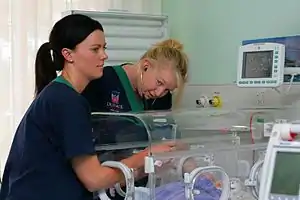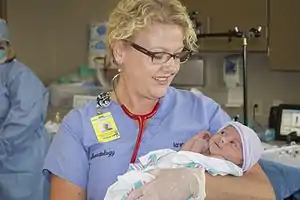Nursing in Australia
Nursing in Australia has evolved in training and regulation since the 19th century.

Nurses are vital to the community. A career in nursing is challenging, while also rewarding as it involves helping sick individuals become healthy again. There are many ways of becoming a nurse in Australia, including TAFE or university courses. There are many places in Australia where nurses can work, including hospitals and schools, with the opportunity to have flexible work hours. The salary of a nurse in Australia depends on what type of nurse they are and their years of experience.[1] There are multiple career pathways one may follow within nursing such as paediatrics, intensive care, oncology, and emergency nursing.[2]
History
Prior to the transfer of nursing education to the university sector, nurses were trained on the job in a three-year course of theory and practice instruction in hospital nursing schools and on the wards commencing with a 6-week preliminary training school (PTS) with the earliest accepted entry age being 17 years. First, second and third year student nurses were often distinguished by the number of stripes on their uniform caps and or belts. Hospital-based examinations were held each year and a successful pass meant progression to the next year and a fail meant a student nurse was cut, no second chances. Three years of student nursing culminated in final year exams. Student Nurses were paid employees of the parent hospital and there was no sick leave. If a student nurse missed time off through sick leave over the three years of training this time was added on to be worked at the end of the three years and if not worked a nurse was not allowed to graduate. Hospitals awarded distinctive badges and veils (think the flying nun) upon graduation. In addition, state registering authorities awarded a badge of registration. These were generally worn with pride on the uniform collars.

As early as the 1930s, attempts were made to establish university credentialed nursing courses in Australia, most notably by then director of nursing at the Royal Melbourne Hospital and the University of Melbourne. As recently as the 1970s, Sandra Stacy, one of the first Australian nurses to attain a PhD enrolled in a school of anthropology to submit her thesis.
In the late 1970s, the Royal College of Nursing Australia pioneered a course that became the Diploma of Applied Science (Nursing), awarded by the Lincoln Institute in Melbourne and Cumberland College in Sydney. The transfer of nursing education to the university sector continued throughout the 1980s, and gradually hospital schools ceased operating. In the early 1990s, universities finally granted nursing education the same status as allied health, and granted bachelor degrees in nursing rather than diplomas for entry-level courses.
The first move towards baccalaureate recognition was the development of the Bachelor of Applied Science (Advanced Nursing), a post graduate degree that required registration as a registered nurse as a prerequisite to admission and completion of 16 units. This course is no longer offered, and has been superseded by the transition of "post basic courses" conducted by various hospitals as a form of in-service training to the tertiary sector. The College of Nursing still runs post graduate certificate courses for nurses in many specialities.
The transfer of nursing education to the university sector from the hospital setting was the result of long-time efforts by leaders in Australian nursing, notably, pioneer nurse educator Merle Parkes.[3] It was opposed by the medical hierarchy who viewed the development of highly trained professional nurses as a threat to their monopoly on the delivery of high-level health care. Many nurses themselves opposed the transfer on the grounds that "hands on experience in hospitals" would be lost. One underlying cause of the opposition was that of societal views toward appropriate gender roles: nursing as a "female" profession and medicine as a "male" profession.ceo
Historically, a "double" or "triple certificated sister" would have been a registered nurse who held general, midwifery, psychiatric, or other range of certificates. The post nominal "RN (DC)" or "RN (TC)" was used by some nurses to signify this attainment.
Nurse practitioners are being introduced into the Australian healthcare community. It was only in December 2000, that the first Nurse Practitioner was authorised to work in Australia. Since then there are approximately 700 practicing throughout Australia. To become a Nurse Practitioner you must firstly apply to the Nursing and Midwifery Board of Australia, NMBA. After applying to the NMBA you are then required to provide affirmation of the following to be considered:[4]
· General registration as a nurse
· The required hours of experience in a leading practice, which is 3 years full-time within the space of the last 6 years
· A Masters degree which is from an approved provider
Legal regulation
As of 1 July 2010, nurses are regulated by the Nursing and Midwifery Board of Australia, an agency under the Australian Health Practitioner Regulation Agency (AHPRA) under the National Registration and Accreditation Scheme. The practice of nursing was previously governed by state and territorial nursing regulation authorities. The Australian Nursing and Midwifery Accreditation Council (ANMAC) was established in 1992 and works with these authorities to facilitate a national approach to nursing and midwifery regulation. Which has now been superseded by the Nursing and Midwifery Board of Australia (NMBA).

Types of nurses
Nurses fall into the following major categories:
- Nurse practitioner (NP)
- Registered nurse (RN)
- Enrolled nurse (EN)
Supported by the following:
- Assistant In nursing (AIN)
Mandatory Registration Requirements for Nurses in Australia
Before being able to work, nurses must become registered in Australia. There are specific registration requirements that all new applicants and applicants renewing their registration[6] must meet:
· Criminal history check – international as of 4 February 2015
· Professional indemnity insurance arrangements
· English skills
· Continuation of professional development
· Recency of practice
Education
Registration as a registered nurse now requires a Bachelor of Nursing, considered the foundation for any future specialisation within nursing. Postgraduate diplomas provide further vocational training for specialist areas. Masters level courses are available in both research and course work streams; a specialist course has been developed to provide preparation for registration as a nurse practitioner. Professional doctorates are also available.
Australia has a long tradition of post-basic courses, usually of a six-month (minor) or twelve-month (major) duration, which included midwifery, maternal and child welfare, psychiatric, perioperative (theatre nursing), intensive care, and coronary care in later years, as well as a myriad of other courses. They are now provided by the university sector as postgraduate diplomas or post graduate certificates, depending on the length and complexity.
There are options available for hospital trained nurses to upgrade their qualifications to a Bachelor of Nursing (post registration). However, most opt instead to undertake specialist courses such as a postgraduate diploma or certification in the area of their clinical interest.
Enrolled nurses (Endorsed) complete a Diploma of Nursing and are trained in the "technical and further education" (TAFE) sector and also Universities, although still obtaining the same degree. Course length has been increased to 18 months to include a module that permits enrolled nurses to dispense oral, rectal and transdermal medications, as well as perform intramuscular injections, subcutaneous injections, and intradermal injections. Additional post-graduate certificates are offered, including administration of intravenous medications. Diploma (Endorsed) and Certificate nurses can attend University to gain a Bachelor of Nursing in just 2 years, as their previous qualification allows most to enter at 2nd year.
Twenty-nine per cent of registered nurses in Australia received their first nursing qualification in a country other than Australia and nurse migration trends to Australia have seen an increase in international nurses from developing countries.[7]
Professional titles
The professional courtesy title "sister" has fallen into disuse and disapproval, even though it was formerly used by both male and female registered general nurses. The title "nurse" was used when addressing enrolled nurses.
Salary
The salary of a nurse depends on two factors: the type of nurse and the years of experience in the position.
- Nurse Practitioner: $118,419 to $123,629
- Registered Nurse: $63,468 to $92,954
- Endorsed Enrolled Nurse: $54,701 to $68,216
- Assistant in Nursing: $52,228 to $57,182
The initial figure would be the commencing salary, then after years of experience the nurse could potentially receive the larger figure. Figures for registered and enrolled nurses range from the lowest graduate public sector salary to the top increment without higher level, advanced skill or senior roles.[8] The salary rates[9] above are the most current rates in Australia, which are from 1 January 2020.
See also
- Australian College of Nursing
- Nurses and Midwives Tribunal, superseded complaints forum
References
- "Salary". Government of Western Australia - Department of Health. 2016.
- Willett, Bridget (2008). "Careers in Nursing & Midwifery" (PDF). Graduate Careers Australia. Retrieved 11 May 2016.
- "50 Years of Innovation".
- MacLellan, Higgins & Levett-Jones, Lorna, Isabel & Tracy (2015). "Medical acceptance of the nurse practitioner role in Australia: A decade on: Nurse practitioner role in Australia". Journal of the American Association of Nurse Practitioners. 27 (3): 152–159. doi:10.1002/2327-6924.12141. PMID 24895143.
- "Neonatal Nurse Practitioner". Wikipedia. 2016.
- Cashin, Heartfield, Bryce, Devey, Buckley, Cox, Kerdo, Kelly, Thoms & Fisher, Andrew, Maria, Julianne, Lisa, Thomas, Darlene, Eleanor, John, Deb & Murray (2015). "Standards for practice for registered nurses in Australia". Collegian. 24 (3): 255–266. doi:10.1016/j.colegn.2016.03.002.CS1 maint: multiple names: authors list (link)
- Chun Tie, Ylona Audrey Diana (2019). Playing the game: a grounded theory study of the integration of internationally qualified nurses in the Australian healthcare system (phd thesis). James Cook University. doi:10.25903/5d37b76651e3c.
- Olson, Mark (23 July 2020). "Public Sector Wage rates". ANFIUW. Retrieved 12 August 2020.
- "Nurses and Midwives - Wage Rates" (PDF). Queensland Health Department of Education and Training. 2016.
Further reading
- Chiarella, M. The Legal and Professional Status of Nursing. New York: Churchill Livingstone, 2002.
- Dooley, G. The Transfer of Australian Nursing Education from Hospitals to Tertiary Institutions: An Annotated Bibliography. Bedford Park, S. Aust: South Australian College of Advanced Education Library, 1990.
- Russell, R. Lynette. From Nightingale to Now: Nurse Education in Australia. Sydney: Harcourt Brace Jovanovich, 1990.
- Schultz, Bartz. A Tapestry of Service: The Evolution of Nursing in Australia. Melbourne: Churchill Livingstone, 1991.
External links
| Wikimedia Commons has media related to Nursing in Australia. |